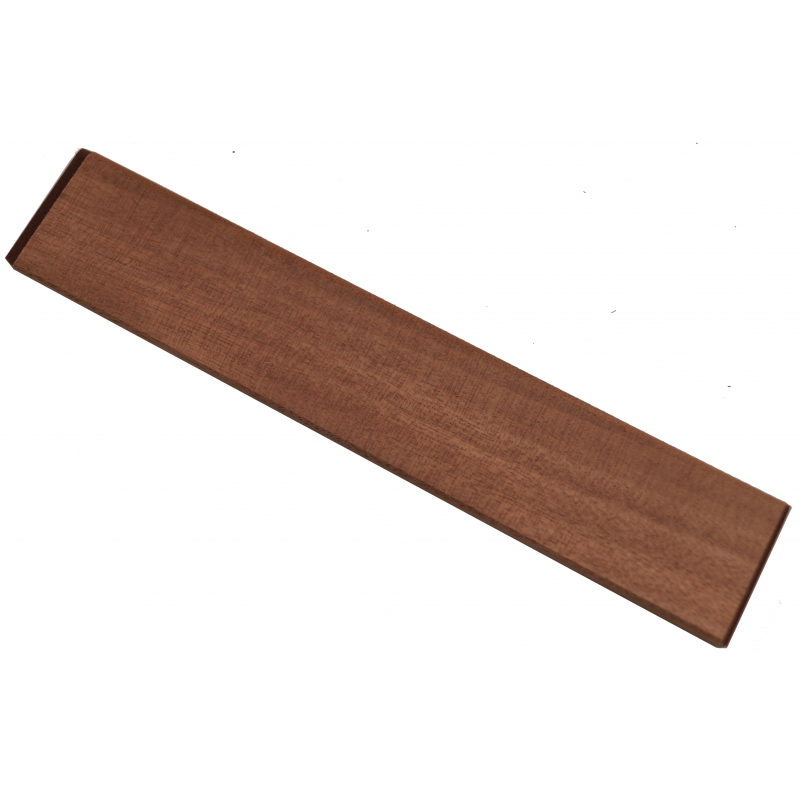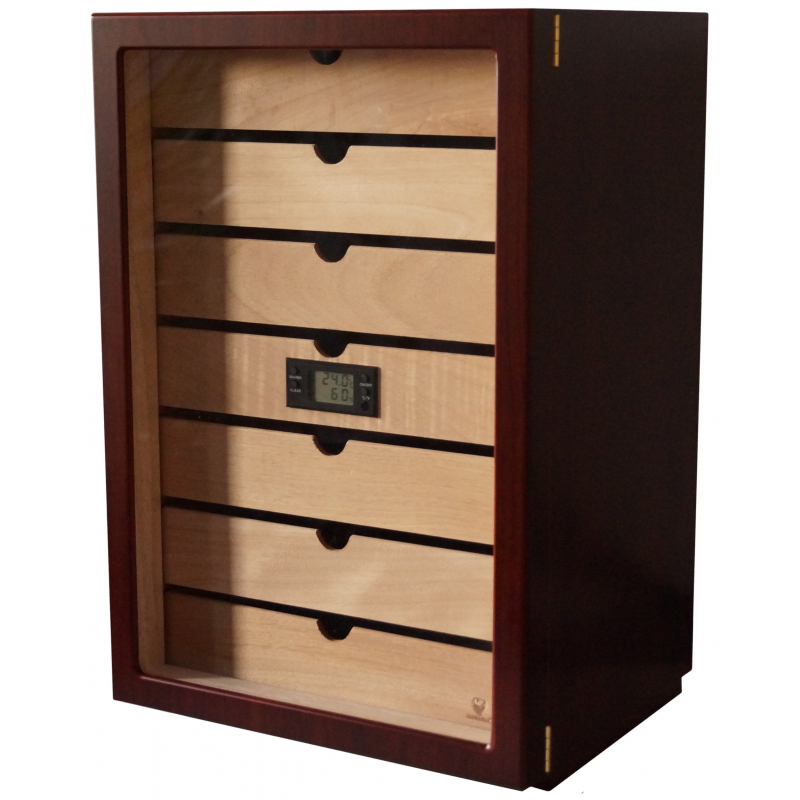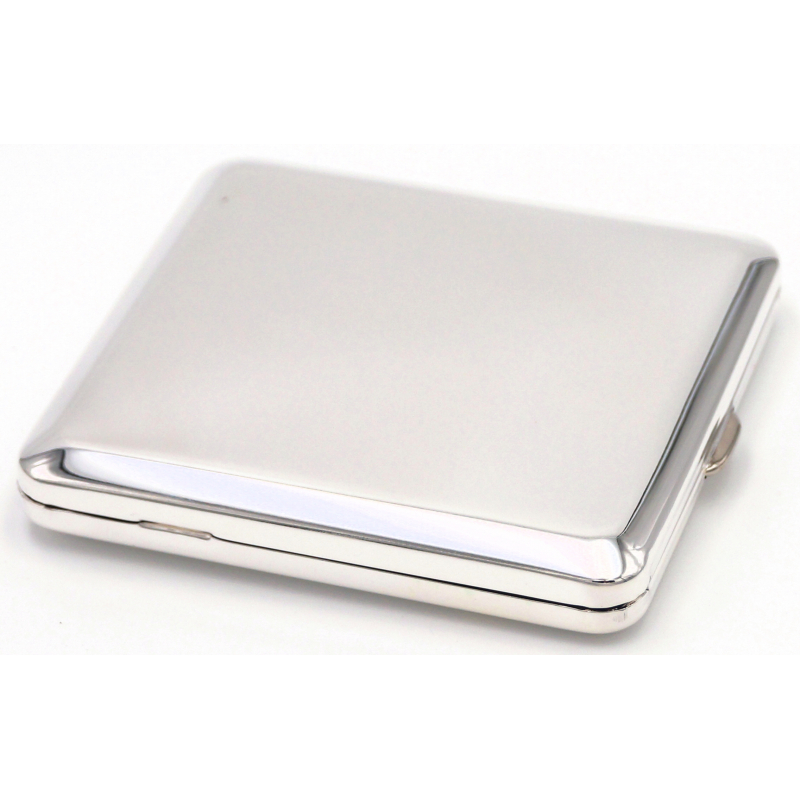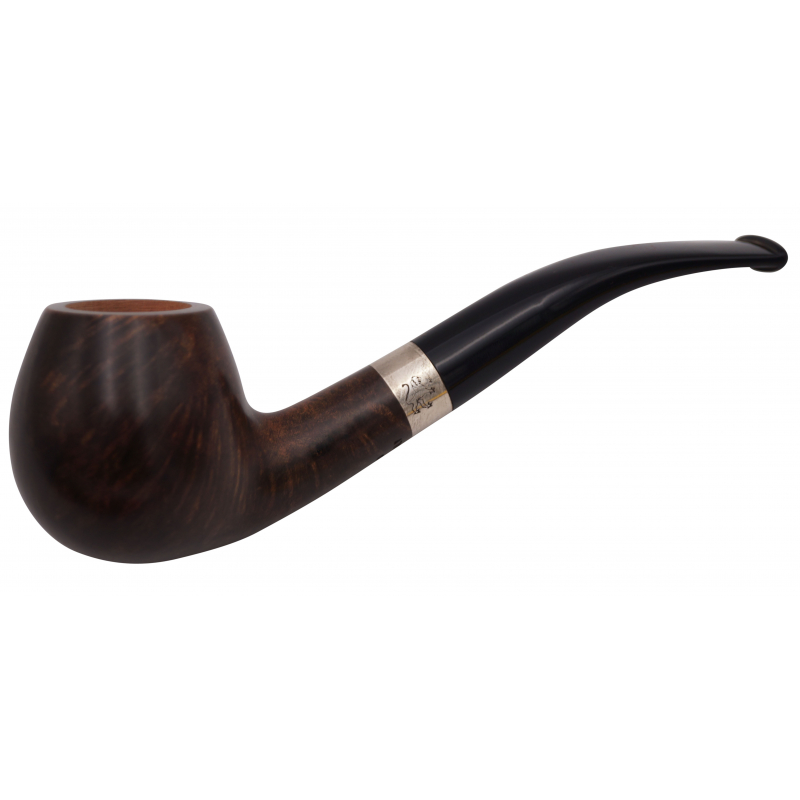- Description GERMANUS Divider for Humidor VeterThis divider or sparator made from wood allows you to distinguish ou cigars in your humido… truncate always cuts down the length to 125 characters. So it will only shorten the string if it exceeds 125 chars. Therefor, only show the button when the length of the text is greater or equal then 126 characters. More
- Properties
- Reviews
- FAQ
Product information "GERMANUS Divider Humidor Veter"
GERMANUS Divider for Humidor Veter
This divider or sparator made from wood allows you to distinguish ou cigars in your humidor. Available with the divider is tape to fit the divider exactly in your humidor. The humidors are handcrafted. Slight differences in size are possible.
Dimensions: 222 x 35 mm
Please select the variant from the list on the side.
Compatible humidors are listed in the Accessories section.
No dimensions and weight defined for this product.
No properties defined for this product.
0 of 0 reviews
Average rating of 0 out of 5 stars
Login
Boveda Humidipaks for Cigar Humidors
Boveda is a good regulator, but was not actually designed primarily as a humidifier.Function
The Boveda system is a disposable humidifier. It contains a salt mixture. The bags themselves consist of a semi-permeable membrane which, according to the manufacturer, is designed to keep foreign substances out. According to the manufacturer, the sachets should be disposed of after 2-3 months. Boveda Humidifpaks absorb moisture and release it again. In abstract terms, the question is what happens when the moisture contained has been released but no new moisture is added from outside.
Application quantity
The amount of Boveda required depends on the volume of the humidor to be humidified. However, this quantity is greater than is often assumed.
It should be noted that a wooden humidor is physically a box. This means that it cannot simply break. For example, it contains no gearing mechanism that could lose its function. If the humidity is too low, too little humidity is simply provided.
The moisture that Boveda can distribute comes from the product itself. If there is no other source of moisture, it is limited accordingly.
Our advice: If you want to use Boveda, please leave our humidifiers in the humidor. These provide the humidity, Boveda regulates in this case.
In reality, the quantities required are quite high. As an example, a small table humidor measuring 26x22x10.5 cm is shown below.
The quantity of 2 Boveda packs shown is obviously too small for this. If you want to humidify a cabinet with Boveda, the quantities used must therefore be high.
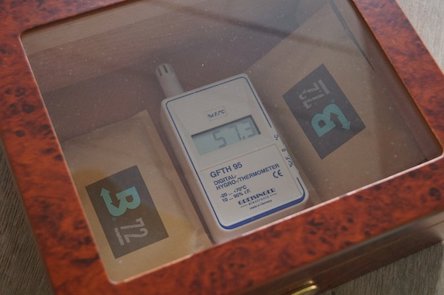
Cigar Spa is made by hand in the west of Cologne, Germany. The product is technically beyond doubt. However, it is advisory intensive. The technical requests we want to take into account with this entry.
Field of Use of Cigar Spa
CigarSpa is characterized by a particularly sensitive release of moisture. High-quality components are used, which ensure appropriate accuracy. CigarSpa wants to moisten cigars carefully. Too rapid a change in moisture can cause cover sheets to burst and, if broken, can present risks.
However, this cautious operation has the side effect that CigarSpa is a great accurate solution, especially for table humidors, where a lid closes a bottom firmly. It looks different with cabinets. You can also use CigarSpa in cabinets. Here I would use CigarSpa but from experience rather than regulator as the only humidifier. So if you have a Schrnak with passive sponge humidifiers or acrylic polymer humidifiers, we recommend using CigarSpa as a regulator, as CigarSpa itself does not provide enough performance in many cases. We believe that this does not pose a major barrier in the application.
The major problem of electronic humidifiers is usually a possible Fehlbefeuchtung with defective sensor / other electronic defect. As a result, you should keep a closer eye on electronic humidifiers than passive solutions. Unattended passive solutions that work well can dry out or slowly over-moisten. An electronic humidifier, which acutely fan assisted cigars in the event of a defect so to speak, can cause actual damage after years of good function. The risk of a defective humidity sensor can also lead to such a result. This is unlikely for CigarSpa due to its cautious nature.
In short: CigarSpa alone in normal table humidors / small chests. In cabinets often like in addition to passive solution as a regulator.
As always, with questions of this kind, there are different opinions that one can talk shop. We would advise from experience accordingly.
More information is given in the GERMANUS Humidor Brevier, which is included with GERMANUS humidors, but can also be purchased separately.

Wie bei so mancher Frage allgemeiner Natur möchte ich mich aufgrund der praktisch denkbaren Einzelfälle auch hier differenziert äußern. generell stellt dies überhaupt kein Problem dar. Der Dom.Rep. Zigarre ist es im Endeffekt egal, ob sie neben einer Habanos liegt und nebenan ggf. noch ein Nicaragua Stumpen eingelagert wurde. Nun gibt es aber durchaus Raucher mit feinem Gespür, die genau das Gegenteil behaupten. Ich persönlich bin aus eigener Erfahrung der Ansicht, dass es gewisse Wechselwirkungen geben kann. Um diese zu erschmecken, braucht es aber eine feine Nase und Erfahrung. Jede Zigarre gibt ihrerseits Duft an die Umwelt ab. Der Umgebungsduft am Lagerort spielt eine gewisse Rolle. So zweifle ich einen "Aromenübergang" an wie ihn manche Raucher behaupten festzustellen. Gleichwohl wird man bei 2 sehr prägnant duftenden Zigarren, die sehr unterschiedlich sind, eine gewisse Abhängigkeit nach einiger Zeit feststellen. Ich denke da etwa an eine ölige Maduro, die nach Pferdemist duftet neben einer ganz trockenen Dom.Rep. Zigarre mit leicht blumigem Trockengeruch.
Wichtig jedoch: Bitte lagern Sie niemals aroamtisierte Tabkwaren und keine aromatisierten Zigarren in einem Humidor zusammen mit nicht aroamtisierten Raucherzeugnissen. In den Fällen ist eine Vermischung sehr wohl ein Problem und zu erwarten.
Viele Zigarren kommen in Cellophan (Cello) oder Tube. Hier kann man überlegen, die Lagerung in der Eigenhülle durchzuführen.
Generell möchte ich aber unterstreichen, dass eine "Aromenhochzeit" einer der Mythen ist, die heutzutage durch das Internet katalysiert werden. Bitte machen Sie sich nicht zu viele Sorgen.
Zwecks Ordnung gibt es für die meisten GERMANUS Humidore Teiler separat zu bestellen. Wenn Sie in dem Punkt Sorge haben, wäre dies ein einfacher Ausweg.
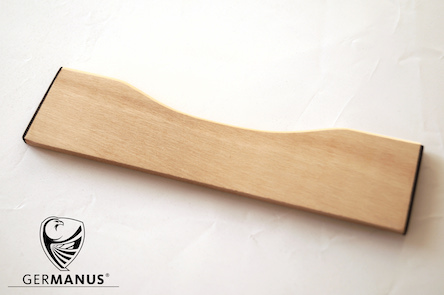
Baiscally, there are 3 kinds of woods that are used or should be used for humidor veneers. Each of them is usable for cigar humidors.
Most popular among these is Spanish Cedar Wood, which is also known as Cedro. It provides for a pleasant aroma inside the humidor. Cigar Smokers, who have their first humidor, are sometimes a bit irritated about the smell, which can be surprisingly strong. This odour is wanted. Cedar Woood is expensive. Not every well aged wood conveys that smell. But when you encounter the smell, you know that it guarantees for a certain level of quality.
In addition to the positive effects on teh cigar aging, the odour helps to keep tobacco worms away and therefore helps to protect cigars.
It’s cedar wood, but not Cedro: American/Canadian Cedar wood. Better known as Red Cedar. The odour is different from the Spanish Cedar Wood, but also quite pleasant. The shade of the wood in your humidor mainly depends on the tree where it comes from. It doesn’t allow a sure identification of the used kind of wood.
Each of this precious woods has nothing in common with the regular domestic cedar from our forests. The wood of the domestic cedar cannot be used for humidors. To keep it simple and the text readable, we refer to cedro and the cedar wood of humidors as „cedar wood“ or simply “cedar”. This never refers to the domestic cedar from our European forests.
Finally, Mahagony. It’s also called Mahogany or Mahagoni or Mahogani. No matter how it’s spelled, this refers to a precious wood that smells neutral. Mahagony is often used for humidor-veneers. It’s not bad, but most smokers prefer cedar for the above given reasons.
We stay away from Mahagony, even if products with a Mahaogony veneer can be of good quality. The vast majority of our customers is in favour of cedar wood. That’s why we concentrate on cedar.
Distilled water from the local drugstore is not identical with water that is offered in pharmacies. Distilled water that is sold at drugstores is usually only decalcified, not sterilized. Pharmacy water is also sterilized. If you have no opportunity to buy sterilized water, decalcified water is better than just water from the main. Like many cigar smokers we simply use the cheap decalcified water with some of my personal humidors and never had any problems with mould. Depending on the worth and quality of your cigars, nevertheless, I recommend to use sterilized water. A good cigar needs something nice to drink while aging. J If you have a distiller for decoration purposes, you could also take it and make some sterilized water yourself.
Please remember, that the kind of water you fill in your Humidifier just sanitized your Humidifier. The cigars rolled by a normal human person, touched by a lot of hands, packed in a wooden box, opened and loaded in your humidor with your hands already contain germs and bacilli. (Cigars from the shop sometimes are already infected with mould, which you cannot see, because it just grows inside the cigar. Placing such a cigar in your humidor can infect your other cigars.) The same applies to the food we eat. Everything we see and touch is contaminated with germs.
However, the whole issue is not a main problem as which it appears on some sites on the internet: In order to prevent germs from mass spawn, which means mould, check your humidor regularly. The humidity should always be at a level of ca. 60-70% and the temperature should not be higher than 20°C. If you, additionally, clean your hands before touching your cigars, you will probably have no problems at anytime.
If you would like to buy anything to reduce the risk of mould, I recommend an exact Digital Hygrometer: The humidity is not always identical at any place and in each corner of your humidor.
Alternatively, you can simply boil water and let it drain off. Please never use water from the tumble dryer, because of possible.
If you use liquids, please make sure that the humidifers don't become to dry, because some fluids could drain off accidentally, when the H2O contained is gone and only the thicker parts of the liquid remain.
We recommend using distilled water as not all customers have clean water from the tap as is available in the UK and Germany. It is important to use water that is as germ-free as possible. For example, you can simply boil water yourself if you are unsure. A low lime content is important to avoid blockages.
Distilled water from the pharmacy is the safest recommendation worldwide.
Once the humidor has been run in, the humidity can drop again.
There are two scenarios here.
Empty humidor: Humidification in a humidor is always designed for a certain degree of filling. This is usually around 50%. Cigars act as a buffer and reduce the air volume. If no cigars are stored, the humidity will gradually drop again.
Cigars have been stored in the humidor: Many cigars are commercially conditioned at approx. 60-65%. These values are ideal for long-term storage and are unproblematic during transport or in the event of fluctuations that may occur during distribution. Stored in the humidor, where the user usually aims for approx. 70% humidity, the cigars first absorb water. In doing so, they draw moisture from the air in the humidor. This can result in a drop in the relative humidity in the humidor.
This is normal. The level can be raised further with an additional source of humidification. This is not necessary or advisable: excessive fluctuations in humidity affecting the cigars can lead to cracked wrapper leaves. The moisture content in the cigar and its surroundings can become too high. The tension may then appear on the wrapper leaf in the form of cracks. Gentle humidification is therefore always beneficial. Our humidors are equipped with humidifiers to ensure gentle and sufficient humidification.
Again and again we receive emergency calls from cigar owners who are looking for a humidor in time trouble. What to do if no humidor is available, but the cigars are already waiting at home? Please respond calmly in such cases. :) It is only important that you do not expose the cigars to extremely fluctuating environmental values. So keep them away from the sun, coolness and heat. Leave the cigars in the box or outer packaging. Even more resistant are cigars in tubo or cellophane (cello).
As far as available, a food-safe and preferably air-tight box provides a good deposit. If such is not available, the wardrobe or similar would be recommended.
The background: Possible loss of water is not a problem at first. The loss must not be very abrupt. Otherwise cover sheets may be ruptured by the different moisture content in the cigar. (The same applies to humidification.)
Water can easily be replaced by gentle moistening later.
The problem is a dehydration that lasts more than a few weeks. The oils of the cigar leaves (tannins) are not replaceable. However, the volatilization of these oils is slow and only plays a role over a few months. So there can be no really acute emergencies when cigars without humidor are owned.
If the cigars are supplied in tubo or cellophane, dehydration sometimes does not play a disastrous role, even when persisting over decades. We have been able to revive finds of Davidoff cigars from Cuban production in the 1970s. This product is packed in cellophane. The oils in dried form were therefore still preserved.
In general, even with the volatilization of oils after a few months may be perceived negative nuances in the taste. But there is still no talk of ruining the cigar. After rewetting, it usually takes a skilled palate to distinguish a few months of dried goods from properly stored goods.
Please store your cigars promptly. From a panic or worry, we can only advise against experience. Your cigars will forgive you as described above.
Refuel Humidor Humidifier
Question: How many times can I refill a crystal humidifier?
Answer: As soon as the humidifier crystals have shrink remarkably or the humidifier lost size, please refill like dispatched. The crystals can be reloaded for almost infinite times. With regards to the affordable costs of a replacement, we recommend replacing crystals about once a year for hygienic reasons. But you can of course use them much longer.
Question: Should I let a cup with distilled water for about 1 week inside the Humidor? Or should I just steep some towel with the distilled water, pass it through the wood, and wait for a couple of days?
Answer: Both ways will lead to the same end. The booklet is formulated in a way that should prevent mistreatment.
If you wipe the humidor out with a wet towel and let it absorb the humidity for a couple of days, that's OK. (The water could leave stains, however. And some people tried to fill the whole humidor up with water. "The more the better" they thought. That's what I wanted to prevent from happening again.
Placing a cup inside is safe and easy, but take more time.
Question: My humidity level dropped from inital 70% after seasoning the humidor to a lower level? (65, 60, 55 percent)
Answer: The humidor itself cannot be broken. We sold over 50.000 units o f these over the past 12 years. It's maybe the most popular model all over Europe. As long as the glass isn't broken, it's OK. The construction of the humidor is very good.
A dropping humidity level after storing the cigars inside is totally OK: The cigars absorb moisture and the humidity level therefore drops in the first time. The exact reaction depends on the condition of your cigars and the saturation of the humidor.
If correctly calibrated the mentioned drop in humidity sounds totally OK and explainable.
-
Have you adjusted the hygrometer? Hygrometer calibration If there's a need to adjust the hygrometer, depends on the actual purchased model.
Please also see our article on hygrometers: Humidor Hygrometer accuracy Please see the displayed value as a guidance value. - To make sure: Please setup the humidor according to Humidor setup
- The humidor needs a certain minimum quantity of cigars to provide stable values. How many cigars have you stored inside?
- Have you filled the humidifier? If the humidifier(s) aren’t enough in the first time, you can simply add a little cup of water, which you place inside the humidor.
Antwort am Beispiel eines Einsteigers, der rund 20 Zigarren unbekannter Größe einlagern möchte.
Danke für Ihre Anfrage. Die optimale Humidor-Kapazität hängt in der Tat von der beabsichtigen Lagermenge ab. Die genannten Kapazitäten sind natürlich nur grobe Richtwerte und in Corona Zigarren gerechnet. Lagern Sie also vor allem Panatela, werden Sie vermutlich mehr unter bekommen, rauchen Sie Churchill Zigarren, kann die Kapazität in Ihrem Fall für weniger Zigarren reichen.
Wenn Sie eine gute Kiste Zigarren einlagern, ist ein Modell für ca. 50 Zigarren durchaus sinnvoll. Aus Erfahrung lagert man doch mehr ein als man denkt. Damit empfiehlt es sich, tendenziell eine Nummer größer zu kaufen. Es gibt aber durchaus viele Raucher, die wirklich nur ein gutes Dutzend Zigarren vorhalten wollen.
In dem Fall würde ich eine Nummer kleiner kaufen.
Die Befeuchter aller Humidore sind an einer normalen Füllung ausgerichtet. Diese sollte bei zumindest 50% der Gesamtkapazität bzw. des Gesamtvolumens liegen. Der Humidor sollte zu >50% ausgefüllt sein. (Wie viele Zigarren Sie dafür benötigen ist nicht wichtig.)
Alle unsere GERMANUS Humidore wurden mit einem Befeuchtungssystem ausgestattet, dass dem Humidor angemessen ist. Wir rechnen dabei nicht nur grob Pi mal Daumen, sondern prüfen real jedes Modell durch.
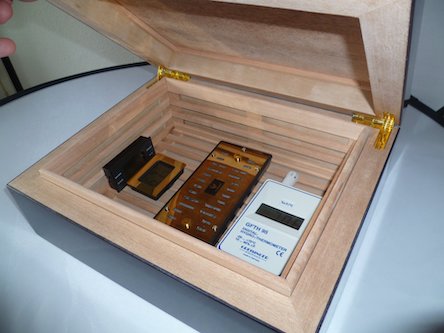
We are asked regularly, which kind of glass was used in humidor xy. The used glass is different depending on the manufacturer and product. For our GERMANUS humidors I follow this view: My opinion is rather tolerant of both kinds of glass, acrylic glass and genuine glass.
Genuine glass makes a nice impression.
Acrylic Glass got some advantages on its side, however. These are in my view:
- Better Light protection
- Resitant against Scratches
- Less risk of breaking/damage
- Affordable, but can be hardly distinguished optically from genuine glass, if of good quality
In general most humidors of the lower or middle price glass are made with windows of acrylic glass.
Above all, the danger for the cigars is that they are exposed to humidity that changes too quickly:
Put dry cigars in a humidor or humidor wet cigars on dry wood,so the cover sheets can tear through the tension and the cigar wrapper is ripped then.
In your case, please carefully increase the humidity step by step. The process may have time for a few days or weeks. The slower the less risk. We recommend wiping out the humidor with a wet towel to prevent cigars from being placed on completely dry wood and then supplied with extra moisture because the humidor itself is supposed to absorb them. This can lead to the described problems. Please do not dispose of such cigars, but use a cover slip glue.
For comparison: I have recently put a cigar cabinet into operation. The cigars in foil (cellophane) or box were simply put into it. Then a cup of water was placed inside the humidor. So the the whole seasoning procedure lasted only 5 minutes. The humidity level inside soon reached 65-70%, which is ideal. I did not do any more. If possible, I would therefore leave foils and boxes as possible around the cigars. In a sense, one does not operate on the open heart and can do something "more brutal".
If you store normally stored cigars, this will not occur at all. Helpful in such cases is to insert the cigars only after a certain drying out or not fully in the humidification phase of the wood. You have the problem, for example, if you find a cigar somewhere in a compartment in your car after 2 years. I first bring it up to about 60% and then let it be further moistened. I am absolutely not a supporter of Boveda. But here Boveda resp. Boost do a good service. Exactly for this purpose we offer the 62% variant. This one doesn't need a humidor. A cigar box will do just fine. Boost or Boveda can also be used as a regulator in addition to existing humidifiers in a humidor.
If the child has already fallen into the fountain, i.e. cracks have appeared, please proceed as gently as possible. In most cases, the problem can be limited if you do not humidify further for the time being, but leave the values stable. In any case it is not advisable to bring a dried out cigar from 40% to e.g. 80% in a humidor that is just being put into operation.
I recognized a rating for a product of a competitor lately. It was about a humidor humidifier. The user complained about a not working product. Well, there are differences in quality. Every humidifier can be soaked with distilled water. If this doesn’t work as expected, there’s no malfunction, but an operator error.
If your humidor doesn’t reach the expected values, the following explanatory approach can be also helpful and applicable:
Our GERMANUS humidifier can be soaked easily. Please place it for a couple of minutes in distilled water. 15 Minutes should be enough to do the job. Alternatively, you can insert water at the grille with the help of an injection. Syringes with oder without needle can be bought at a pharmacy or printer shop. By osmotic powers it’s possible that water wouldn’t drain inside due to a inner vacuum, otherwise. The same of course applies to the known humidor liquids.
You will have to deal with the same physical issue that makes a diving bell working. The vacuum cannot escape because of the counter-pressure. How frequently this phenomenon appears with humidifiers also depends on the fluid’s density that you’re using.
Soaked once, the whole issue will be solved.
Please see the following videos, which show the process.
Refill of a Humidifer Box with a Squeeze Bottle (Minute: 1:15)
Humidifier submerged in water
Analogue Standard Hygrometers
Digital Hygrometers
The handling when setting digital hygrometers varies slightly depending on the model. Mostly, there are three buttons: "C" or "Adjust". A short press may switch between ° F and ° C. A long press activates the calibration. By pressing "+" or "-" you can set the desired deviation upwards or downwards. Another press on "C" or "Adjust" brings you back to the normal menu.
In addition, some models have the "Max / Min" button, with which you can display previous maximum values or minimum values. The "Clear" button clears this memory.
Button:
Max / Min - Switch between the stored maximum values and minimum values. The values are automatically saved until you press the Clear key.
Clear - Clears the stored maximum and minimum values.
On / Off - Turns the hygrometer on and off
° C / ° F - Switch the display between Celsius and Fahrenheit
Determine reference values
There are several ways to determine the desired ideal value for a hygrometer. In recent years, the belief has become common in some places that exact 70% rel. Humidity must prevail in a humidor. Everything else was dangerous. There are two theses:
- Exact 70% is a possible stock value. In fact, long-term storage tends to occur at around 60%, while cigars for consumption are readily stored by many smokers at e.g. 75%. Personally, I have for the purpose of a small humidor with about 75% humidity in operation with an amount of humidifier capacity above the normal recommended range.
-
For a review, the measuring devices already do not exist or are priceless for the private user resp. not available. However, none of the commercially available hygrometers are able to measure 70% accurately. Achieved ideal values thus give a good picture, but are not based on valid measurements such as would be necessary in medicine. I therefore recommend only aiming for a value "against" 70%. Such thinking saved the user time, nerves and costs.
Cigars do not need an exact 70%.
Unfortunately, the assumption is still carried out by the industry into the world. At fairs, we often meet people smile in conversation about such theses. Due to the topic, all parties are partly put under unnecessary pressure.
I can only advise prudence in the issue of measuring moisture. Who likes to invest in a dew point mirror and medical hygrometer, of course, can do that. These are great devices. The costs are in the more or less elevated four-digit area. The effort drives no cigar lounge known to me, because it's unnecassary. On the other hand, they definitely use the same devices that we manufacture or sell.
There's only demand for a reliable value. There are x methods for that. What they all have in common is that an action in a confined space achieves an inherently reliable level of humidity. We present two popular methods below.
1.) Wet Cloth method
Just wrap the hygrometer in a damp cloth for about 1 hour. It should then stand at about 98%. The needle should be just below 100%, so as not to leave the measuring range.
Advantage: Very simple in implementation, therefore practical.
Disadvantage: Each hygrometer has a precision area in which it measures very precisely. An adjustment above limits thus contains understandable disadvantages.
2.) The steam method
There are many different variations with different considerations. Often, water is boiled and steam is used as a reference point. I advise against it, because too much mistakes are made. No hygrometer wants to be boiled in water. :)
The method takes advantage of the fact that a saline solution provides physically predictable and stable values. In the example, take a vessel (pot). This is filled to at least about 10% of its volume with a saline solution. On 100ml of water come 40g of sodium chloride. So you mix in a 40% saline solution. When the salt is dissolved, place the hygrometer inside on a pedestal, such as an inverted glass. Thereafter, the vessel is closed airtight. At 20 ° C ambient temperature to get the desired value of just over 70%. After 2-4 hours of waiting, you can set the hygrometer to about 74%.
A variation of the pot variant is the following: A small glass (shot glass, Stamperl) is filled with 2 tablespoons of salt and a few drops of water. It results in a salt mixture. This is hermetically sealed together with the hygrometer in a bag. After 2-4h the 74% can be adjusted in the same way.
How to open the hygrometer? We have a collection of opening procedures on some gauges. Please refer to our hygrometer opening site.
I'm looking for a humidor with automatic humidification and temperature hold function so I do not have to think about what's going on with my cigars. How can I store my cigars fully automatically?
There are not really fully automatic humidors on the market. Even if they are advertised as automatic, they still require a minimum of care. Most cigar smokers are looking for an automatic cigar humidor and are actually looking for an electronic humidifier that automatically regulates moisture content. You can use any (GERMANUS) humidor and add a humidor humidifier. The recommended humidifier depends on the humidor model.
Our alternative to electronic Humidor Humidifiers: The GERMANUS Bead System. This is a regulator that is easily added to a humidor. Simply place the regulator in the humidor. The number of necessary regulator units of course depends on the humidor.
For all humidors across the market: Moisture must be added. The tank must be refilled. Just as a car needs new gas from time to time, a humidor needs a stop at the "gas station" to top up with water in the humidifier tank.
Question: I have seen a cheap climate cabinet. Would you recommend something like that?
Answer: The question is very general. Therefore, I would like to give a general guideline. There are wine cabinets from Asia that are equipped with some wood and maybe a humidifier. This is electronics, which was usually never intended to store food in it without wrapping. Wine bottles are sufficiently dense. But some sommelier are worried about negative side effects of such cabinets. The temeprature control if ofter very limited and the noise from those machines is not acceptable to every wine lover. These cabinets are then simply equipped with a simple humidifier to call them a "humidor".
The question is what can be expected for the sometimes surprisingly low prices? In the abstract, this is nothing but a fridge designed for wine storage, which was built for 30-60 € and includes some wood and a humidifier. With an automatic cigar storage as the impression is awoken, this has nothing to do.
We have already been told by customers and competitors of fumes and extremely inaccurate temperature at high noise levels (buzzing). Cigars need reasonably stable but not cold temperatures. These even have a negative effect on the maturation and aging process. Temperature control is a nice feature, but not necessary or central. This feature is bought with unchecked plastics and completely unclear effects of these exhalations on the stored cigars. The permanent noise volume is not quiet in some reported cases.
Important: Automatically working is very little in those fridges. (Those
fridges usually miss electronic humidifiers. But if they have, please
keep a critical eye on them no matter who is the manufacturer.)
I
would not recommend that either, but if you buy a low price German
fridge and some wood for the interior, you have more storage volume at a
better price. Again, this is not recommended. But if you really wanted to put cigars in a fridge, I would choose a tested European product. A lighting is also automatically integrated there. :)
Buying a Cigar Humidor is a matter of trust just like any purchase. Those products are simply very basic wine fridges or coolers where cigars and a normal humidifier are placed. The risk here are fumes and in most offers the absence of a European supplier who would be available in the event of a defect or problem. A guarantee is usually missing completely or is rejected in the real case of defect.
Each individual case must be considered individually. But these are general considerations based on logic thoughts and feedback of customers and competitors. The quality of these fridges is appropriate for the price. :) Electronics in the humidor is always a risk, as it brings the risk of malfunction in the topic of cigar storage.
If I am now asked for my own personal opinion, I personally would not dare the experiment, because the possible success in relation to the possible or expected disadvantages and problems would be much too small.
If you buy such a gastro cabinet, then please with guaranteed safety of the components, a reasonable shielding and reasonable humidification. Such cabinets are usually available from at least 1000 €, more from 2000 € available.
A frequently discussed topic in newsgroups and forums is the wood used for trays and drawers of humidors. In the following, we would like to introduce some possible forms of processing and in particular to clear up prejudices.
Wood in pure form
Again and again, especially on the Internet, the processing of wood panels is considered as ideal or expected value in Humidorbau. Often, such discussions arise when it turns out that some high-end products still have fiber plates in their price. It should be said that a humidor made of simple wood panels will not last long. Even if the wood is completely dried out, it will at least be slightly forgiven over time. A humidor should be wetter inside than outside. As a result, wood inevitably warps. A composite construction (sandwich construction) is therefore obligatory. It's not about the cost of a wood panel. It would be nonsensical to build a humidor body out of it.
MPX, multiplex
These are especially stable hard-glued wooden boards. When wet, they are stable. Anyone who has ever seen driftwood on the beach knows about the function. MPX works well as a core of a carcass. Depending on the construction method, further layers or veneers are applied.
MDF
Completely misused and negative feedback is the use of MDF. MDF is known as pressed cardboard. Valuable humidors would never include such. It is correct that MDF is also disrespectfully called pressed cardboard. However, MDF is currently used by very high quality humidor manufacturers. This may surprise some. The claim can be traced in any well-stocked specialist retailer. The background for use is simply that MDF is very flexible. It does not easily swell under moisture. Therefore, such humidors are quite durable. As everywhere in the humidor no smelling adhesives should be used. MDF as a material is not a problem. The advantage of moisture resistance comes just in the body of the humidor wear. There are different types of construction. A body made of MDF adapts well to changes due to moisture. It is not for nothing that famous cigar importers rely on MDF for the body of their humidors. It depends on how well the humidor has been processed with the material. You will find on the market quite high-priced and very popular models that rely on MDF.
Among the famous users of a MDF made product is Boveda. Boveda builds its wooden holders with a corpus of MDF and uses the advantages of the material for its product:
.jpeg)
.jpeg)
Solid Wood
A good alternative to MDF are solid wood shelves and drawers with solid wood floors. Solid wood refers to thinly glued thin layers of wood, which are therefore very stable and resistant to moisture. Solid wood is quite expensive in the production. For many of our humidors, we already rely on solid wood processing and thus create added value compared to MDF production.
Solid wood cedar
Very nice but also very expensive is the use of cedar (Cedro) for the production of trays floors or drawers. The valuable processing has a very important disadvantage: Cedar bends through damp very quickly. Especially if the floors are provided with large holes or the wood in the drawer of the humidor has no room for expansion, long-term or even medium-term damage to the humidor can occur.
Alternative materials
There is still a narrowing on wood plus cedar. For a long time, various successful trends have been heading the other way. Sapeli (also mahogany) has similar characteristics as cedar, but smells more neutral. Some smokers do not like cedar wood or are afraid of resinification. Therefore he prefers Sapeli. Other manufacturers coat their humidors inside with plastic. Such products are also available in the high-priced segment. The company CigarSpa offers about such cabinets. The ulterior motive: What does not suck is not a factor. A humidor without absorbent surfaces is easier to moisten. Everything depends of course on the humidifier.
I hope to have given a little insight into different materials in Humidorbau. In particular, I wanted to be able to offer anyone interested a point of view from a long experience, which once classifies the belief in good wood and cedar finish. Humidor construction, like many other topics, has different views and currents and several correct answers. Some are just myths. :)
That's a true classic question. Our GERMANUS absorb multiple hundred (!) times their initial size of liquid. Accordingly, the included quantitiy is calculated. That quantity may be lower than some users might think at first glance: More crystals would lift the lid or press themselves through the grille. The limited quantity is important and an actual quality factor of our product.
Please also see our video Setup of a Humidor Humidifier Box with GERMANUS Crystals
Standard Analog Spiral Hygrometer
These hygrometers are reasonably priced and are visually beautiful to look at.
However, since spiral hygrometers give only rough guideline values, which in itself does not detract from the actual function of the humidor, the following recommendation:
As an accessory, I would recommend a small digital hygrometer
Calibration of hygrometers
Every hygrometer has an effective range in which it measures accurately. A setting with extreme value against 100% is therefore always somewhat dangerous, no matter which make you use. Personally, I would rather advise to compare with a second hygrometer. In terms of percentage point exactly is no product under a four-digit price range.
Digital Hygrometer and the accuracy of the humidity measurement
The sensors have a certain spread, the electronics also. This results in an interval of 7%.
It is more likely to measure whether it is 65, 70 or 80%. But it can not be more exact, which is not necessary.
If you are in the interval 65-75%, that fits. Then everything is OK.
In recent years, the belief has become common in some places that exact 70% rel. Humidity must prevail in a humidor. Everything else is dangerous. There are two theses to counter.
- 70% is a possible value. In fact, long-term storage tends to occur at around 60%, while cigars for consumption are readily stored by many smokers at 75% or more. Personally, I have for the purpose of a small humidor with about 75% humidity in operation for which I exceed the regular amount of humidifier capacity.
-
For more accurate measuring, the measuring devices do not exist or are too high priced for the private user resp. are not available. However, none of the commercially available hygrometers are able to measure 70% accurately. Achieved ideal values ??thus give a good picture and convey an idea of accuracy, which is deceiving to some extent. Those values are not based on valid measurements such as would be necessary in medicine. I therefore recommend only aiming for a value "about" 70%. Such thinking saves the user time, nerves and costs.
Cigars do not need an exact 70%.
Unfortunately, the assumption is still carried into the world. At fairs, I often meet people who make me smile in conversation. People put themselves under unnecessary pressure and would to well to convey a more realistic idea.
I can only advise prudence in the point of measuring moisture. Who likes to invest in a dew point meter and medical hygrometer, of course, can do that. These are great devices. The costs are in the more or less elevated four-digit area. The effort drives no cigar lounge known to me, because it is not necessary. On the other hand, they definitely use the same devices that we manufacture or sell.
Marc Andre, who is a German humidor manufacturer, once made very meaningful comments on the subject.
I hereby exceptionally allow myself a direct quote:
Do not let it drive you crazy
"With a commercial hygrometer you can measure whether the humidor tends to have 65, 70 or 75% rel. Damp lie. You can not expect more. Again and again I get calls from worried cigar smokers, who, quite upset, report that they are moistening with the electronic humidifier HYDROCASE but simply can not get to the 70%. At 66% is over. Considering that the sensor in the HYDROCASE has a 1.8% error, the hygrometer itself is about 3-4% (if it is calibrated perfectly), and then there are temperature variations - then 66% is a perfect value.
High precision measurement with dew point mirror
If you really want the rel. Humidity measured with high precision, you can only do this with a precision electronic hygrometer with a capacitive sensor or with a dew-point mirror. Such electronic precision hygrometers start at about € 280.- and for a dew point mirror you have to lie down a four-digit amount. But then measure to half a percent exactly."
My own 50 Cents: There are many discussions on the internet. There are many interesting, useful and very useful forums. However, forums also always run the risk of artificially problematizing topics on scientifical issues and thus problematic topics. The topic Humidity measurement is m.E. such a case. As Marc Andre so sensibly describes, no one with normal technology is able to make such accurate measurements. This is also not necessary: We receive daily questions on all sorts of topics. Humidity measurement is one of the central topics. There are absolutely heartfelt letters from desperate smokers, who only measure 71% and genuinely fear for their enjoyment and are honestly driven by fear of losing their whole stock of cigars. I am always personally very sorry for this. There is a person who is really worried and is spending a lot of time driven by fear. In fact, everything is in the best order. As a result, it can happen that people completely lose the pleasure of cigar enjoyment. I am humanly responsible for this suffering, I am personally personally sorry and is also regretful on business.
Therefore, my earnest request: Please do not go crazy. :) Use a sensible hygrometer like our GERMANUS Digital Hygrometers . Please enjoy your cigars and look forward to it. Cigars are made to relax and enjoy the smoker. A cigar will not break if it is 65, 68, 72 or 75% rel. Humidity is stored. Care and reflection are useful as always in life. But cigar storage, as we offer it, is not rocket science for the user. Do not worry. Please also visit our article about long time impacts on cigars, which are stored in a dry environment.
best regards, Philipp Pietsch
Owner of GERMANUS
How crystals absorb moisture resp. water or other fluids:
Positioning the humidifier box inside the humidor:
Question: Should my cigar be exposed to as much air as possible? Is storage on shelves that are open at the bottom necessary / reasonable / advantageous?
Answer: The slots of the trays should prevent waterlogging (which in normal humidification anyway does not occur.) Most customers store at least sometime complete cigar boxes in the humidor. There is no ventilation to one side.
I know that there is the advice to air cigar as much as possible. However, in our opinion, it is all about preventing moisture nests. The cigars themselves can, as in boxes, be stored with very little air. In fact, a close / rather airtight maturation of the maturation will even do well in the long term, as the major oils have less air contact. (A cellophane cigar that dries out tends to rewet much better than an open-topped cigar, even after a long dry period, that is, more than 6 months.)
Mould in a Cigar Humidor is a popular topic on internet forums and facebook groups about cigars. I already explained how the illogical search for the “ideal” 70% can be a delusional idea. The topic cigar mould is connected to that obvious fear.
We receive questions on a regular basis asking for a diagnosis. In almost each case cigar bloom or non-toxic food mould fungi is the diagnosis. This text is meant to give a basic overview. As Owner and Operator of GERMANUS we’re asked for diagnosis.
In most cases the found condition is cigar bloom. Cigar bloom is a good sign of aging and also an absolutely normal sign.
To give a rough guideline: Doesn’t a cigar smell unpleasantly, can you smoke it (because it isn’t too wet), does she taste at least acceptably, and you most likely won’t have a mouldy cigar at issue. A mouldy cigar smells rotten. Nobody would eat rotten meat, because it smells so badly. In the same way you won’t accidentally smoke a rotten cigar. The standard bodily functions should prevent accidental consumption. Just like the alarmism in connection with best before dates, mould and cigars are a topic of alarmism.
The cigar Journal published some very useful articles about the topic.
Important: There are most astounding stories that smokers tell. I can tell stories about smokers, who fill their humidor up with water like an aquarium and give their cigars a nice swim in the pool. There are smokers, who soak their humidifiers before they go on vacation. They add an additional humidifier to make sure there’s enough moisture during absence. And they place the humidor with windows in the bright sunlight. Then they go away and leave their greenhouse alone.
But these are exceptional incidents. The usual cigar smoker pays at least some attention to his cigars and thinks his actions through. He sees a little white fluff on his cigars, which he soon recognises. Please keep calm in such moments. That’s a viable situation.
If there’s an actual case of mould, the experienced smoker doesn’t put to much attention to the issue. Cigars are a natural product, which are usually hand rolled and have seen many hands before finally be packed into boxes and later be smoked. The box will get through changing climate. Germs and Spores are included in either case. Affected cigars can be isolated. If the humidor shows fluff e.g. at the humidifier’s grille, you can wipe it off and have an eye on the area during the next time.
There are two reasons that should reassure you.
Cigar Bloom
It’s usually the cigar bloom, which is wrongly taken for mould. The pictures showcase Ramon Allones Specially Selected directly from the German importer 5th Avenue. I personally smoked the cigars with greatest pleasure. The taste was just great. The aroma inside the box is among the most pleasent smells that I ever got the luck to smell. If you get a box of these, be happy about your luck. Cigar Bloom mostly appears on cigars during summer. (It got to do with the surrounding temperatures around.) Many Cigar Smokers are surprised to see cigar bloom on their cigars, when summertime begins. But cigar bloom is just a proof of a well aged cigar.
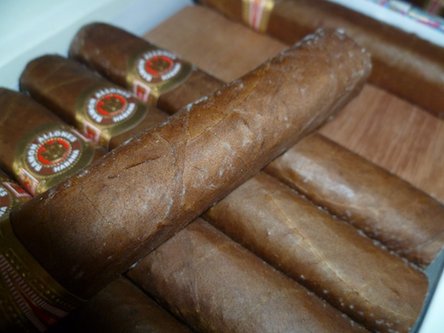
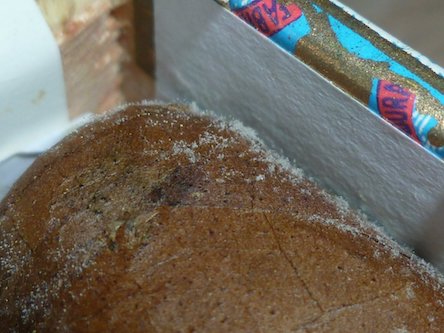
Good and Bad Mould
There are different kinds of mould. I repeatedly discussed the topic with Marc Andre, who writes articles about cigar storage for the European Cigar Journal. In consultation with the 5th Avenue (Importer of Habanos in Germany), they gave the following statement, which I quote in original German language and an English translation:
In praxis cigar bloom is often mixed up with food mould fungus. From the view of the smoker, it’s almost identical and there’s no real difference: Both are signs of aging and are not affecting cigars.
„This white fungusis no toxical food mould fungus and shouldn’t be mistaken with such fungus. Food mould fungus is an organic product and toxical. The fluff on the cigars is odourless.
The white fluff is Eurotium – a not toxical fungus. Most cigar boxes automatically contain this fungus. In contrast to classic food mould fungus, which demands for a high humidity level to be able to grow, Eurotium sperms can grow at rather low humidity levels of ca. >60%. Eurotium inhabitates almost every cigar. You just can’t see it, because i’s invisible. Only when the cigar evaporates water and transports the salts (Minerals of the tobacco) to the wrapper, it makes a visible impression. That salt is a perfect fertile soil for the spores.
The fluff doesn’t look nice, but it absolutely doesn’t affect your cigars. Just wipe it off and wait. After some time, when the cigar will have evaporated its minerals, it won’t appear any more.” Marc Andre
„Allerdings ist dieser weiße Flaum nicht mit dem nach Schimmel riechenden Lebensmittelschimmel zu verwechseln. Lebensmittelschimmel ist ein Zersetzungsprodukt organischer Substanz und ist giftig. Das ist bei dem weißen Belag auf dem Schwamm nicht der Fall. Der Flaum ist praktisch geruchlos.
Dabei handelt es sich um so genannten Eurotium – ein nicht toxinbildender und geruchloser Pilz. Diesen haben Sie in praktisch jeder Zigarrenkiste automatisch drin. Im Gegensatz zu klassischem Lebensmittelschimmel der eine hohe Luftfeuchte zum wachsen benötigt, können Eurotium-Sporen schon bei einer relativen Luftfeuchte von 60% entstehen. In jedem passiven Befeuchtungssystem haben Sie diese Sporen drin – Sie sehen sie nur nicht. Und Eurotium ist auf jeder Zigarre . Sie sehen ihn nur nicht. Es sei denn, die Zigarre verdunstet Wasser und transportiert das im Tabak enthaltene Salz (Mineralien des Tabks) auf das Deckblatt. Ein perfekter Nährboden für diese Sporen.
Der Flaum sieht unschön aus, ist aber vollkommen unschädlich für die Zigarre. Wegputzen und warten. Nach einiger Zeit (wenn der Tabak seine Mineralität ausgedunstet hat) wird das nicht mehr auftreten.“ Marc Andre
Temperature
The perfect temperature for growing mould is ca. 5-15°C. A simple experiment to prove the assumption can be performed with a piece of cheese. If the temperatures are higher, the cheese won’t soon grow mould. If a white fluff appears, it’s most likely Eurotium, which is also known as a benign food mould fungus.
Once again an excerpt of Marc Andre:
“If mold does grow on the cigar, this is almost always Eurotium.spp, a fungus that does not form toxins and that grows in every mattress and in every environment with a relative humidity above 60%. This fungus only grows on the surface of the cigar, on the wrapper, is entirely harmless and is easily confused with cigar bloom. If this fungus structure appears on the cigar, you simply wipe it off. If cigars are stored cool at a storage temperature of 16°C and 65 to 70% relative air humidity, you will notice that the cigars feel relatively dry. This is due to the fact that as the temperature falls below 18°C, the relative air humidity must be increased in order to ensure the 13% by weight of water in the cigar. Hence the air humidity is increased to figures between 75 and 80%. And that is where the attentive reader will see the problem: the low-temperature and ongoing high air humidity increases the risk of mould. As long as it is only Eurotium, it is harmless, but if in fact Apsergillus flavus is growing on the cigars, it becomes a problem. And this risk occurs where storage is at a low temperature and high relative air humidity.”
"Sofern tatsächlich Schimmel auf der Zigarre wächst, handelt es sich fast immer um den Erotium.spp, einen nicht Toxin bildenden Pilz, der in jeder Bettmatratze und in jeder Umgebung mit einer relativen Feuchte von mehr als 60 Prozent wächst. Auf der Zigarre wächst dieser Pilz nur oberflächlich auf dem Deckblatt, ist vollkommen harmlos und kann leicht mit der Zigarrenblüte verwechselt werden. Tritt dieses Pilzgeflecht auf der Zigarre auf, so wischt man es einfach ab. Wenn nun Zigarren gekühlt gelagert werden, so wird man bei 16 °C Lagerungstemperatur und 65 bis 70 Prozent relativer Luftfeuchte feststellen, dass sich die Zigarren verhältnismäßig trocken anfühlen. Das liegt daran, dass ab Temperaturen von weniger als 18 °C die relative Luftfeuchte sukzessive erhöht werden muss, um die 13 Gewichtsprozent an Wasser in der Zigarre zu gewährleisten. Also wird man die Luftfeuchte erhöhen auf Werte zwischen 75 und 80 Prozent. Und da bemerkt der aufmerksame Leser das Problem: Geringe Temperatur und andauernd hohe Luftfeuchte erhöhen die Schimmelgefahr. So lange es sich nur um den Eurotium handelt, ist das harmlos, wenn aber tatsächlich ein Aspergillusflavus auf den Zigarren wächst, dann wird es brenzlig. Und diese Gefahr besteht bei Lagerungsbedingungen."
Video of the most popular German Pipe Youtuber: Ralligruftie
Ralligruftie and me came across the topic of mouldy tobacco in connection with natural pipe tobaccos. Ralf’s interest into the topic grew and therefore I put forward the idea of making a video about the mould topic. Ralf made this video about tobacco and how tobacco can change under circumstances. I presented some of the materials to him, upon which the video is based. He’s a pipe smoker. He therefore puts more emphasis on pipe tobacco.
Thanks to him for also mentioning cigars and cigar storage in his video. I asked him to do so and of course are very happy that he made some comments. He made once again a great video. I like the way how he discusses the topic and also the calm way in which he classifies mould as one peculiarity among others inherent with tobacco.
Cigar humidors shouldn’t be airtight. They should always convey elimination of air to a certain degree. A well built cigar humidor cabinet is built in such a way that it constantly looses an amount of moisture. That can be achieved e.g. through intentional gaps and clearances.
On the internet tightness of a humidor is usually falsely presented as quality characteristic. In general, there are 2 topics, which contradict that opinion:
Cigars breathe
Cigars evaporate they react with and in air. Air Exchange is crucial.
Exchange
If the surrounding conditions change, that will have a direct impact on the humidor and the cigars in it. They must react to the changed conditions. Fluctuations of temperature and rel. Humidity outside the humidor are compensated. The cigar humidor cabinet should maintain a constant level of relative humidity. That doesn’t mean that a humidor should be airtight, however. When the temperature falls, the rel. humidity rises.
When the temperature rises that won’t lead to falling humidity. In fact the humidity will rise. Cigars and humidor have absorbed moisture, which they set free now. If the humidor was hermetically airtight, this would result in too high levels of humidity. The moisture needs to be transpired to the outside of the humidor. Gaps in the door are a possible measurement to guarantee that transpiration.
Important hint to prevent a popular misunderstanding:
Misunderstandings are a common issue, when it comes to humidors with built-in clöearances, gaps and door-seals. That seals aren’t meant to seal the humidor to stop transpiration. Those seals in our humidors are meant to protect the wood of the door and frame, when it’s closed. One could also call the door-stops. They are built in our humidors for the same reason that room doors have such little seals. Isolation isn’t the pursued goal. It’s protection.
Links: An essay of Marc Andre on Tightness and Cigar Humidor cabinets, published in Cigar Journal
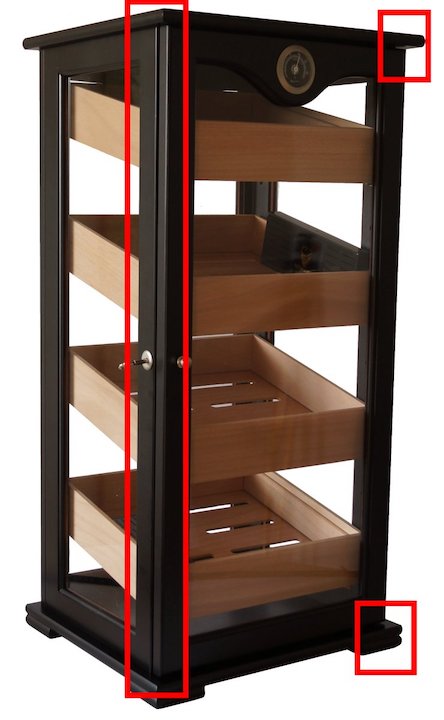
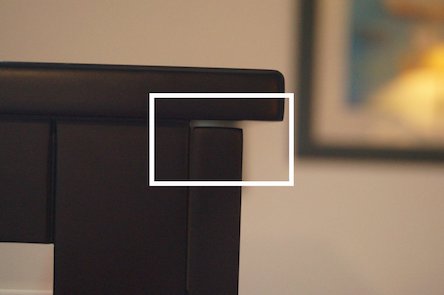
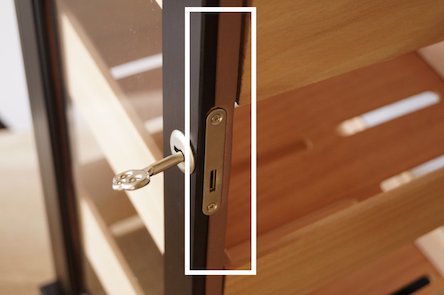
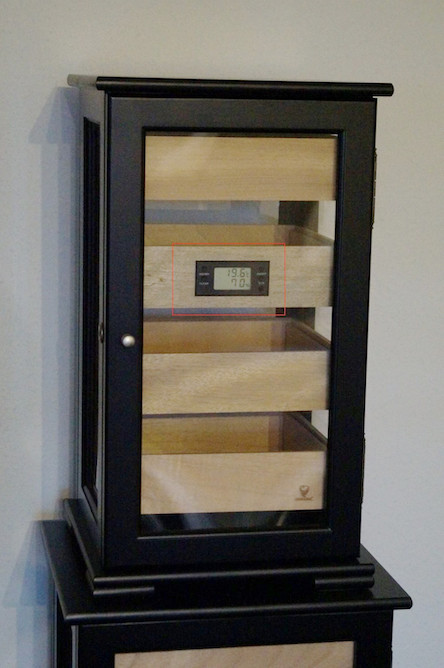
Frage: Lagern Sie alle Zigarren bei um 70%?
Wir und auch ich persönlich lagere Ware zum Rauchen bei ca. 70%, die eigentliche Langzeitlagerung erfolgt aber bei eher 65%. 60% sind auch noch OK. Langzeitlagerung meint Zeiträume von deutlich über einem Jahr. Typischer Weise sind das Zigarren, die 3,4,5 oder auch >10 Jahre lagern.
Es gibt Meinungen, die in die Richtung gehen, dass eine geringere Luftfeuchtigkeit langfristig besser als eine hohe sei. Ich vermute, dass die Öle in der Zigarre leicht flüchtig werden, wenn der Feuchtegrad zu hoch ist. Daher ist es bei längeren Lagerungen tatsächlich eher sinnvoll, die 70% eher zu unterschreiten.
Ich persönlich meine, den Eindruck mit eigenem Gaumen bestätigen zu können.
Frage: Welches ist Ihre Empfehlung für die optimale Luftfeuchtigkeit für Langzeitlagerung von Zigarren? Sie empfahlen um die 60% als optimal. Stimmt dies?
Das ist eine gute Fragestellung. Konkret zur Frage: Wir und auch ich persönlich wähle 60% für die Langzeitlagerung. Den Verzehr plane ich nach einer Lagerung bei gut 65%.
Bei mehr empfinde ich die meisten Zigarren als zu süffig. Zudem steigt das Risiko bei technischen Defekten im Falle elektronischer Befeuchtung.
(Ist man 1 Woche verreist und der Sensor hat einen Messfehler von 10%, sind es maximal 75%. Lagert man bei 72%, kann man bald bei >80% liegen. Wenn dann dazu noch Hitze kommt, kann das schon zu viel sein.)
Aber die Grundempfehlung ist wirklich aus dem Bereich der speziellen Ansichten. Fragt man 4 Leute, hat man 4 Meinungen dazu.
Ob nun 60% oder 65% sollte das persönliche Gustum entscheiden.
Der Gedanke ist einfach, dass die Öle in der Zigarre bleiben sollen und die Nachfermentierung möglichst sauber ablaufen soll. Und das funktioniert nach dem Empfinden einiger (so auch von mir) besser bei eher 60% als bei eher 70% auf lange Sicht.
Es gibt auch wissenschaftliche Erklärungsversuche, die im Cigar Journal auftauchten. Ich persönlich bin skeptisch, ob man die biologischen Prozesse so sehr vereinfachen kann. (Ich denke nicht.) Meiner Erfahrung nach unterscheidet sich die Idealfeuchtigkeit auch abhängig von der Zigarre, also je nach Tabak und Ernte. Aber damit belastet sich eigentlich niemand. :)
Populär wurde die These um 2003 herum durch Min Ron Nee, der sich entsprechend in seiner Enzyclopädie äußerte.
Time and again, 16-18 °C is recommended as the optimum storage temperature. While one may still almost reach such values in winter, these are hardly achievable in summer. The solution for some cigar smokers: you put the cigars in a humidor with cooling function. In most cases, these are very simple wine climate cabinets that are rudimentarily converted into a humidor.
What effect does the temperature have on the maturation of a cigar?
If the cigar is stored open and surrounded by fresh air, the ammonia notes will be gone after a few months and after 2-3 years the cigar can smell flat. The bouquet has virtually evaporated into the surrounding air. To prevent this, one uses a humidor.
However, not the temperature, but the amount of fresh air the cigar is exposed to and the relative humidity are the really relevant influences. The temperature is only a relative factor that is used to calculate the relative humidity. Therefore, we recommend storing cigars as much as possible in boxes, cellophane or tubo as shipped. Open storage is of course also no problem and is also carried out, for example, in cigar stores. However, such cigars should be smoked over time. For periods longer than 2 years, i.e. about 5 years or even 10 years, storage in box, cello or tubo is recommended.
Answer to the above question: Even higher temperatures are not a problem, if they do not start abruptly. The relative humidity remains the same. Abrupt onset would be, for example, positioning a humidor in the blazing sun. From approx. 20°C, the temperature can increase to values >50°C. In addition, please reduce the humidity in summer a little to about 65%, so that the cigar does not become soft.
For the purchase of cigar refrigerators, that is, a cigar humidor with temperature control, this means accordingly that such are superfluous. This is more a nice gimmick than a necessity.
Does a low temperature affect the risk of mold?
The answer to this question is easy to reproduce: when does a piece of bread become moldy? The fastest way for a piece of bread to go moldy is in the refrigerator. In a bread box at room temperature, on the other hand, mold is unlikely to occur. The bread will dry out at most. Other foods would wither. It is hardly possible to create mold on cigars at temperatures above 22°C. So to anyone who wants to store his cigars as safely as possible and cools them down to do so, we have to say that he is exposing his cigars to an unnecessary risk. At more than 22°C you will need permanent values of > 75% relative humidity to produce mold.
You can already tell from this: When it comes to a real mold infestation, a lot must have gone wrong in the storage over a longer period of time. Our separate FAQ on the subject explains this in more detail. If mold actually grows on the cigar, it is almost always Erotium, a non-toxin forming fungus that grows in any bed mattress and in any environment with a relative humidity of more than 60 percent. On the cigar, this fungus grows only superficially on the wrapper, is completely harmless, and can easily be mistaken for cigar blossom. If this fungal growth appears on the cigar, simply wipe it off.
About the problem: Relative humidity states that cool air can store fewer water particles than warm air. So a chilled cigar must absorb more water than a cigar stored at room temperature. Now humidity is necessary nutrient condition for fungus growth.
Low temperature and constantly high humidity increase the risk of mold accordingly. As long as it is only the Eurotium, it is harmless. Other fungal species (Aspergillus flavus), however, should not be grown. Exactly this danger exists however and in itself also only, if one stores in such a way cooled. Note: Please do not confuse mushrooms with cigar blossom, which occurs increasingly in the summer months and is a harmless sign of maturity. It occurs in both warm and cold storage.
Does coolness protect against cigar bugs?
The short answer is no. There are several classic harmless "problems" that are really just noticeables with no effect. Eurotium mold (wicker-like fibers on the cigar) Plum mite (small, white dots running around on the cigar) Cigar bloom (white, mostly dot-like efflorescence) Unfortunately, the cigar beetle is a real problem.
The beetle larvae perforate the cigars by eating tunnels into the cigar. The little animals are not poisonous. But they can destroy the cigar comparable to the bark beetle in trees. Should you find a cigar with a circular passage, this was probably a beetle. The solution for cigar beetle infestation: freeze the cigars in the icebox for several days at a minimum of -30 to -40 ° C. The freezing process must start quickly, as cigar beetles can adapt surprisingly well to slow-onset coolness. So do not perform a gradual freeze from 9°C to 0°C to - 10°C to -40°C. The beetles will probably survive it and lay new larvae as soon as it warms up again. Answer to the question: The 10°C in a cigar fridge is of no use except to latently harden the beetles against freezing.
Conclusion: Is refrigerated cigar storage and the use of a cigar refrigerator worth it?
The answer is almost always "no". Only if a constant climate is necessary for many years (decades), such a solution may be appropriate. In practice, we have not encountered any case in about 20 years where this would have been the case. Exceptions may be non-air-conditioned rooms in desert areas, which are exposed to the changing temperatures between day and night. However, such rooms almost always have air conditioning and even extremely stable values.
Anyone who wants to store cigars of correspondingly high quality for 30 years usually invests a correspondingly large amount of effort in the project. Here, too, solutions other than a wine climate control cabinet are then the obvious choice. Query: What happens if such a product should be defective after a few years of continuous operation?
Then you have cigars inside with too much water content, which are heated in an enclosed space. They will sweat and you will have unintentionally stored your cigars in a greenhouse. Therefore: moderate temperatures make sense when storing cigars, too much variation is never good, but you will hardly need a refrigerator. (Our customers come from all parts of the world. From Australia to Siberia, from Norway to South Africa).
Viele Zigarrenraucher frosten ihre Zigarren. Frosten meint dabei die Einlagerung im Gefrierfach, Kühltruhe oder Gefrierschrank für einige Tage. Auf diese Weise sollen vor allem Tabakkäfer abgetötet werden. Nach Deutschland importierte Zigarren werden vom Importeur in der Regel ausreichend gefrostet. Bei Eigenimporten etwa aus dem Kuba-Urlaub kann es jedoch Sinn machen, dies manuell zu Hause zu erledigen.
Das Vorgehen ist relativ simpel. Die Zigarren sollten möglichst luftdicht verpackt werden, damit diese nicht austrocknen bzw. platzen. Neben Ziplock Gefrierbeuteln und ähnlichem eignen sich insbesondere wirklich dicht schließende Kunststoffdosen, die mit einer entsprechend guten Versieglung angeboten werden. Die Zigarren sollten dann für einige Tage in der Gefrierung verbleiben. Sofern die Zigarren luftdicht verpackt wurden, würde ich diese langsam auf Raumtemperatur auftauen lassen. Die Umgebung im Humidor sollte nicht zu feucht sein.
Generell gilt ja, dass warme Luft mehr Feuchtigkeit aufnehmen kann. Wird es also demnächst kühler im Humidor, wird die relative Luftfeuchtigkeit steigen. Beim Frosten sind platzende Deckblätter als Folge osmotischen Drucks ein Problem. Luftdicht verschlossen wären meine Sorgen da aber gering.
The question of storing cigars with or without wrapping is a common classic. There are certain degustators who argue that the resins of cigars mix and thereby change the taste of a cigar.
Personally, I can taste it during long storage (> 5 years) with optimal storage. Of course, there are cigars, the mixing up of aroma can be clearly heard. I do not consider it dramatic. That's why I would not separate cigars for me (and I'm sensitive).
However, the storage in Tubos or cellophane casing is advantageous in the maturing process (longer than 2 years). I take the view that such packaged cigars are juicier, better ripen. In comparison, one can use the considerations of the storage of wine in bottles instead of barrels. Any fluctuations in the humidity in the humidor thus have only a very indirect effect.
Important: Keep perfumed cigars (vanilla flavoring) and fire cured cigars (like Toscani) out of Humidor together with regular cigar as far as possible and keep them away from anything else. Here the aroma is indeed coloring.
The mostly green sponge is a simple sponge as it has been known for decades in humidors of cigar humidors. Advantage: A sponge easily absorbs various liquids, regardless of the type of liquid. Disadvantage: A sponge does not regulate during release. So a sponge is a good and still up to date humidifier as well as the basis for regulating fluids.
Crystals give moisture quite regulated. Crystals also absorb most liquids. However, some caution is needed if the water (H2O) has evaporated and only thicker liquids remain, which have been added to the water for the liquid. These viscous residues can then run off unintentionally.
Today's standard in cigar humidors is likely to be humidifier crystals. Our GERMANUS humidifier crystals are a German product made in Germany that is personally packed by us. More details about GERMANUS Humidor crystals can be found here.
